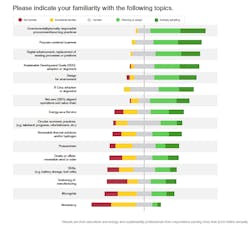Why Don’t More Companies Use Microgrids in their Climate Disaster Plans?
Wondering why more companies aren’t incorporating microgrids into their climate disaster plans? The answer may be pretty simple. They still don’t know what microgrids are.
That’s one of the findings from research released today by Schneider Electric about how organizations are transforming their business models in response to climate change.
Schneider, one of the most active companies in the microgrid arena, in September and October surveyed 100 global companies earning more than $250 million in annual revenue about their familiarity with various climate-related technologies and strategies.
The good news? Companies know more about microgrids than they do biomimicry. The bad news? They know less about microgrids than a lot of other climate strategies, among them B Corp adoption or alignment, net-zero aligned operations and value chain, and prosumerism.
Schneider points out a big problem the results revealed — businesses lack knowledge about the practical solutions that can help them immediately begin decarbonizing. Some of the “most immediately available and effective climate action solutions” — such as microgrids and renewable energy — are less understood, the company wrote in a release that accompanied the results.
“While we are delighted to see that many major organizations are actively thinking about climate change and the risks it poses to their business, we were surprised to learn that familiarity with readily available and practical solutions to reduce carbon emissions is mixed. In order for organizations to truly transform their business, it is critical to go beyond traditional methods of energy management and business practices, and leverage the latest technologies and solutions to drive bold and measurable decarbonization outcomes,” said Susan Uthayakumar, president of Schneider Electric’s Sustainability Business Division.
The findings echo research done by the Civil Society Institute that mined US voters for their thoughts about microgrids. It turned out that voters, too, were largely unfamiliar with the technology — although when they learned about microgrids they expressed support for them.
Business Model Transformation Databook: 2021 Report. Courtesy of Schneider Electric
The Schneider survey also found that organizations are actively thinking about climate change and how to modernize their energy management to prepare. Most of those interviewed had identified climate risks to their operations — only 3% believe their operations are not at risk. Yet only 7% have completely transformed their business in anticipation of future environmental or social challenges and only 21% consider their organization to have advanced significantly in making their business model more environmentally or socially responsive.
Schneider, which was recognized earlier this year by the Corporate Knights Global 100 Index as the world’s most sustainable corporation, said the findings show the complexity and scope of the climate challenge, something that cannot be addressed by a single organization, industry, country or government.
Track news about the use of microgrids in climate disaster plans. Subscribe to the free Microgrid Knowledge Newsletter.
About the Author
Elisa Wood
Editor-in-Chief
Elisa Wood is the editor and founder of EnergyChangemakers.com. She is co-founder and former editor of Microgrid Knowledge.
